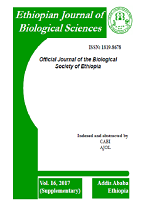AN EVIDENCE OF PAST INTROGRESSIVE HYBRIDIZATION BETWEEN LABEOBARBUS ETHIOPICUS AND L. INTERMEDIUS IN THE ETHIOPIAN RIFT VALLEY, EAST AFRICA
Abstract
Analyses of nucleotide sequences of mitochondrial DNA (cytochrome b fragment) in 30 common barbs (Labeobarbus intermedius) from Lake Langano in the Ethiopian Rift Valley revealed the genetic heterogeneity of the samples. Whereas 29 individuals shared the same haplotype similar to those found in the poorly structured assemblage of L. intermedius sensu lato inhabiting the Rift Valley and basins of western Ethiopia, a single individual possessed a haplotype found exclusively in small-scaled Ethiopian barb L. ethiopicus. The latter species is phylogenetically distant from L. intermedius from any Ethiopian basins and differs from it by the substantially increased lateral line scale counts. Labeobarbus ethiopicus is the narrow range endemic of the Lake Zway basin. Presently barb migration from Zway to Langano is impossible because of the high water mineralization of Lake Abijata located on route. Past introgressive hybridization between two barb species could be enhanced by higher water level in the Zway-Langano-Abijata-Shala lake basin during humid periods in the course of paleoclimatic oscillations. Additionally, the increased lateral line scale counts were found in the Langano barbs compared to other barb population from the central part of the Ethiopian Rift valley, while the barbs from this region exhibited the increased values of this character compared to any other L. intermedius populations from Ethiopia and Kenya. These increased values could be a result of gene flow from L. ethiopicus to L. intermedius. The endangered status of L. ethiopicus as well as L. intermedius population from lakes Zway and Langano is highlighted.
Downloads
References
Alekseyev, S.S., Mina, M.V., Dgebuadze, Y. and Mironovski, A.N. (1996). Small “large barbs” spawning in tributaries of Lake Tana: What are they? Folia Zool. 45 (suppl.1): 85–96.
Aljanabi, S.M. and Martinez, I. (1997). Universal and rapid salt-extraction of high quality genomic DNA for PCR-based techniques. Nucleic Acids Res. 25(22): 4692–4693.
Banister, K.E. (1973). A revision of the large Barbus (Pisces, Cyprinidae) of East and Central Africa. Part II. Bull. Br. Mus. Nat. Hist. (Zool.) 26: 1–148.
Banister, K.E. (1984). Three new species of Varicorhinus (Pisces, Cyprinidae) from Africa. Bull. Br. Mus. Nat. Hist.(Zool.) 47: 273–282.
Baxter, R.M. (2002). Lake morphology and chemistry. In: Ethiopian Rift Valley Lakes, pp. 45–60 (Tudorancea, C. and Taylor, W.D., eds.). Backhuys Publishers, Leiden.
Benvenuti, M., Carnicelli, S., Belluomini, G., Dainelli, N., Di Grazia, S., Ferrari, G.A., Iasio, C., Sagri, M., Ventra, D., Balemwald, A. and Kebede, S. (2002). The Ziway–Shala lake basin (main Ethiopian rift, Ethiopia): a revision of basin evolution with special reference to the Late Quaternary. J. East Afr. Earth Sci. 35: 247–269.
More inside the PDF
